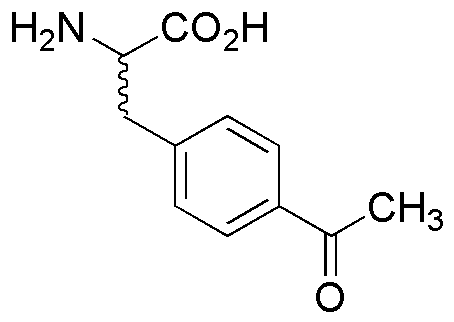DL-4-Acetylphenylalanine is widely utilized in research focused on:
- Pharmaceutical Development: This compound serves as a building block in the synthesis of various pharmaceuticals, particularly those targeting neurological disorders, due to its structural similarity to amino acids.
- Protein Engineering: It is used in the modification of proteins to enhance their stability and functionality, making it valuable in biotechnology and enzyme engineering.
- Research on Neurotransmitters: The compound is studied for its potential effects on neurotransmitter systems, providing insights into treatments for conditions like depression and anxiety.
- Cosmetic Formulations: Its properties are explored in the development of skin care products, where it may contribute to improved skin hydration and elasticity.
- Food Industry Applications: Used as a flavoring agent, it can enhance the taste profile of various food products, appealing to manufacturers looking for natural flavor enhancers.
General Information
Properties
Safety and Regulations
Applications
DL-4-Acetylphenylalanine is widely utilized in research focused on:
- Pharmaceutical Development: This compound serves as a building block in the synthesis of various pharmaceuticals, particularly those targeting neurological disorders, due to its structural similarity to amino acids.
- Protein Engineering: It is used in the modification of proteins to enhance their stability and functionality, making it valuable in biotechnology and enzyme engineering.
- Research on Neurotransmitters: The compound is studied for its potential effects on neurotransmitter systems, providing insights into treatments for conditions like depression and anxiety.
- Cosmetic Formulations: Its properties are explored in the development of skin care products, where it may contribute to improved skin hydration and elasticity.
- Food Industry Applications: Used as a flavoring agent, it can enhance the taste profile of various food products, appealing to manufacturers looking for natural flavor enhancers.
Documents
Safety Data Sheets (SDS)
The SDS provides comprehensive safety information on handling, storage, and disposal of the product.
Product Specification (PS)
The PS provides a comprehensive breakdown of the product’s properties, including chemical composition, physical state, purity, and storage requirements. It also details acceptable quality ranges and the product's intended applications.
Certificates of Analysis (COA)
Search for Certificates of Analysis (COA) by entering the products Lot Number. Lot and Batch Numbers can be found on a product’s label following the words ‘Lot’ or ‘Batch’.
*Catalog Number
*Lot Number
Certificates Of Origin (COO)
This COO confirms the country where the product was manufactured, and also details the materials and components used in it and whether it is derived from natural, synthetic, or other specific sources. This certificate may be required for customs, trade, and regulatory compliance.
*Catalog Number
*Lot Number
Safety Data Sheets (SDS)
The SDS provides comprehensive safety information on handling, storage, and disposal of the product.
DownloadProduct Specification (PS)
The PS provides a comprehensive breakdown of the product’s properties, including chemical composition, physical state, purity, and storage requirements. It also details acceptable quality ranges and the product's intended applications.
DownloadCertificates of Analysis (COA)
Search for Certificates of Analysis (COA) by entering the products Lot Number. Lot and Batch Numbers can be found on a product’s label following the words ‘Lot’ or ‘Batch’.
*Catalog Number
*Lot Number
Certificates Of Origin (COO)
This COO confirms the country where the product was manufactured, and also details the materials and components used in it and whether it is derived from natural, synthetic, or other specific sources. This certificate may be required for customs, trade, and regulatory compliance.


